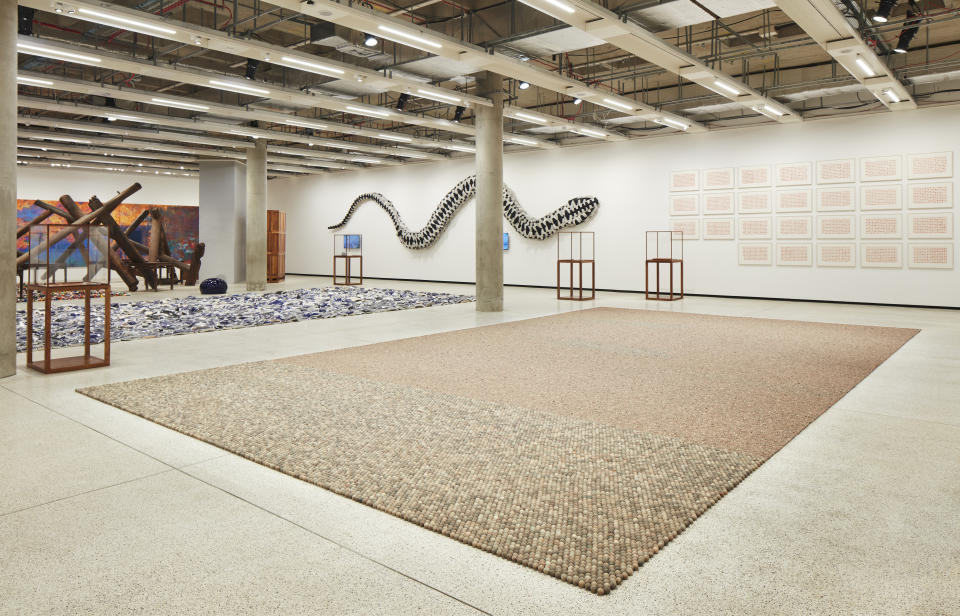Ai Weiwei Gets Personal

LONDON — Ai Weiwei is sitting meditatively on the third floor of the Design Museum here, where his first major design exhibition, “Ai Weiwei: Making Sense,” is about to open to the public on Friday.
He’s wearing a navy uniform and sitting by an empty long black table with empty chairs surrounding him.
More from WWD
The artist is present and is still trying to put the pieces of his life together, for it all to make sense.
“‘Making Sense’ is what we do every day before we make any decisions or judgment. We always have to know who we are and why we are here, and how we’re going to handle our relationship to the outside world,” he says in his calming voice.
“At 65, I’m an older fellow, but I’m sure there’s a lot ahead of me, so I try to make daily feelings irrelevant, so I can be refreshed. My mind stays young and fresh, fortunately that’s my profession,” he adds.
For Weiwei, to be young minded is much deeper than waking up and deciding it’s going to be a good day. It starts with revisiting his memories and comparing them to past generations, which drives him for new interpretations on life.

“If you’re still searching for new interpretations, then you’re just as fresh as anybody,” he says.
The Chinese artist’s showcase at the Design Museum is made up of fragments of his experiences that he’s been collecting since the ‘90s — by placing them in one huge room in squares, mapping out his life and career for everyone to witness.
Near the entrance, more than 250,000 porcelain spouts are grouped together, from teapots and wine ewers dating back to the Song dynasty, where imperfect pieces were broken off. This is Weiwei’s take on the vast porcelain production in China a thousand years ago, as well as freedom of speech. On April 3, 2011, he was arrested at Beijing Capital International Airport and detained for 81 days on the basis of economic crimes.
Another square includes 200,000 neatly laid out porcelain cannonballs, also from the Song dynasty; 4,000 pieces of stone that Weiwei found in a flea market from the late Stone Age; broken porcelain shards from his Beijing studio, which the Chinese state had demolished in 2018, which represents turning his pain into art, and a field of Lego bricks, which the artist started working with in 2014 to create portraits of political prisoners. Lego briefly stopped selling to Weiwei, which in turn encouraged his fans and members of the public to donate to him.

The Lego artwork continues onto the wall with a 15-meter-long reimagination of Claude Monet’s “Water Lilies 1914-26” made up of 650,000 pieces.
Other artifacts of Weiwei’s in the exhibition include a glass toilet paper; marble takeout box; a jade anal bead, and a hanger made from crystal glass symbolic of Weiwei’s time in detention as it was one of the few objects he was allowed.
“There are many layers and they always have personal stories. They have to affect me deeply that I decide to make something to maybe release my expression,” he says.
Weiwei is renowned for the large scale of his work, such as his 100 million porcelain sunflower seeds filling the Turbine Hall of London’s Tate Modern; an inflatable boat carrying 258 faceless refugees at the National Gallery in Prague standing at 230 feet long and 886 wooden antique stools attached to each other at the 2013 Venice Art Biennale.
“People are saying, ‘Oh, why is your work so large in scale?’ I never feel that way because I come from the mountains and oceans, that’s much larger than me. Imagination has no boundaries. If you look at the sky at night, you realize how small you are,” Weiwei says.

He admits to being spiritual without worshiping any particular faith, apart from the sun.
“I only worship the sun,” he says, explaining that the reason he has relocated to Portugal is for the 300 out of 365 days of sunshine and that the country never really went through the Industrial Revolution, which results in no pollution.
Being in Portugal reminds him of a primitive life, like a farmer. He imagines he will be there until “the end comes.”
But when it comes to the subject of showing his art, Weiwei is appreciative of London for giving him his major shows.
“It’s a city that cares about culture and art. The students here are very keen on cultural matters,” he adds.
Weiwei recently bought 30 tonnes of buttons from A. Brown & Co., a 104-year-old button company based in Croydon.
The motivation behind his collection is to stop “the waste among the West.”
“We’re living in a critical time where nature has been exploited. There are so many species disappearing and humans will be one of those species to disappear on this planet. Everything has karma and if we’re being so careless and selfish with no vision for the future then we will all bear the consequences,” says Weiwei.
His next design project is a gold jewelry line inspired by Chinese zodiac with book publisher Taschen that he’s been developing for a few years.
The samples resemble ancient Song dynasty jewelry with its rich hue and bold designs.
“I love pure gold jewelry,” says Weiwei, an aficionado in collecting and a man with taste for everything around him.
Best of WWD


